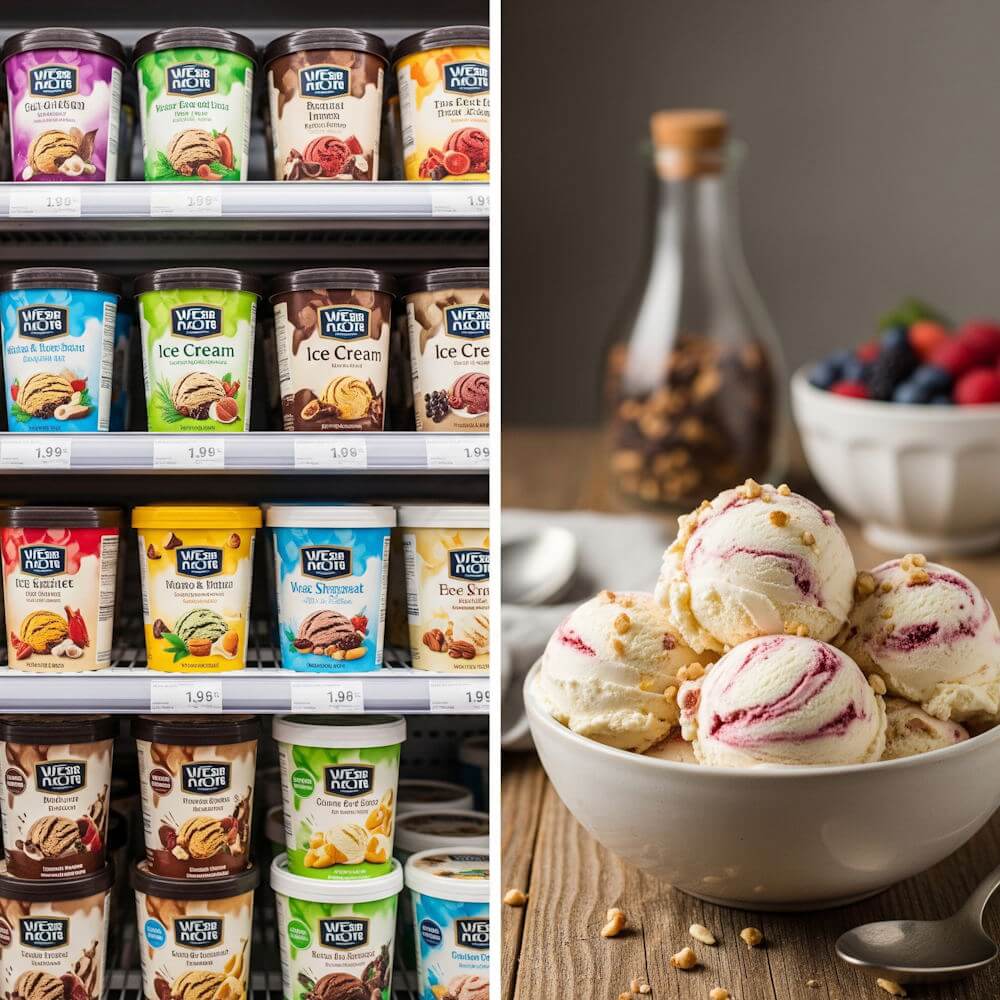Ice cream, a beloved dessert enjoyed by many around the globe, has sparked a long-standing debate between store-bought and homemade varieties. This popular frozen treat comes in countless flavors and textures, appealing to diverse tastes and preferences. While some individuals relish the convenience and consistency of purchasing ice cream from the supermarket, others advocate for the unparalleled quality and personalization that homemade versions can offer.
The accessibility of store-bought ice cream undoubtedly contributes to its popularity. With countless brands and flavors available, consumers can easily find an option that suits their cravings. From classic vanilla to elaborate sundae combinations, the range of choices makes it a quick and satisfying dessert for many. Additionally, store-bought ice cream often incorporates commercial additives and stabilizers that contribute to a smooth, creamy texture, which can be hard to replicate at home.
On the other hand, homemade ice cream enthusiasts emphasize the advantages of preparing ice cream from scratch. By using fresh ingredients and controlling the amount of sugar and flavorings, individuals can create a product that meets their health preferences and even dietary restrictions. Moreover, the process of making ice cream at home allows for unique flavor experiments and variations that store-bought options might not provide, appealing to culinary creativity.
This discourse ultimately revolves around two primary factors: convenience and quality. While store-bought ice cream offers quick access and established reliability, homemade versions provide an opportunity for personalization and possibly healthier choices. As we delve deeper into this topic, we will evaluate the merits and drawbacks of both types of ice cream to help guide consumers in their frozen dessert choices.
The Ingredients in Store-Bought Ice Cream
Store-bought ice cream is a ubiquitous indulgence, readily available in a plethora of flavors and forms. However, beneath the enticing packaging lies a complex mixture of ingredients that play a critical role in shaping texture, flavor, and overall quality. Commonly, store-bought ice cream contains a combination of milk, cream, sugar, and, intriguingly, a host of additional components including stabilizers, emulsifiers, and artificial flavors.
Stabilizers are substances that help improve the texture of the ice cream by preventing the formation of ice crystals. These ingredients allow for a smoother, creamier mouthfeel, which is often more appealing to consumers. Common stabilizers such as guar gum or carob bean gum are derived from natural sources, but they can also be synthetic. While these agents enhance the overall consistency of ice cream, they can sometimes detract from the product’s purity, raising concerns among health-conscious individuals.
Emulsifiers, another class of ingredients in store-bought ice cream, are vital for achieving the desired creaminess. These compounds facilitate the blending of water and fat, ensuring that the ice cream remains homogeneous and free from separation. Generally derived from sources such as soy or egg yolk, emulsifiers contribute to a pleasant texture and enhance the sensory experience. However, they may provoke allergies in sensitive individuals, which should be taken into account when choosing store-bought varieties.
Moreover, artificial flavors are frequently incorporated into ice cream to amplify the taste experience. While these flavors can mimic natural ingredients effectively, they often raise health concerns due to potential links to allergies or cravings. The bright colors and enticing aromas associated with many store-bought ice creams predominantly stem from these artificial additives. Thus, while the accessibility of store-bought ice cream offers convenience, it is important for consumers to be mindful of the hidden ingredients that may affect both health and nutritional value.
The Ingredients in Homemade Ice Cream
Homemade ice cream is often lauded for its rich flavor and creamy texture, largely due to the quality of its ingredients. Typically, the foundation of homemade ice cream includes simple yet fresh components such as milk, cream, sugar, and eggs. These ingredients are not just basic staples; they form the backbone of a wholesome recipe. When making ice cream at home, users have the autonomy to select high-quality milk and cream that are free from additives, ensuring a natural taste profile. This directly contrasts with many store-bought varieties that may contain high-fructose corn syrup and various stabilizers.
Furthermore, the use of fresh fruit, nuts, or even herbs as flavoring in homemade ice cream allows for a custom creation that is often impossible to replicate in commercial versions. For example, when fresh strawberries are blended into a cream base, the ice cream retains the vibrant flavor and color that is indicative of quality fruits. This method preserves the natural sugars and nutrients found in these ingredients, enhancing both taste and health benefits.
Another significant advantage of homemade ice cream is the complete absence of preservatives. Many commercial ice creams include these additives to extend shelf life, which can detract from the overall flavor and quality of the product. By opting for homemade ice cream, consumers can enjoy a pure dessert devoid of any unnecessary chemicals or artificial flavorings. This focus on using real, wholesome ingredients not only elevates the ice cream’s taste but also aligns with a growing consumer preference for transparency and quality in food products.
Taste Comparison: Store-Bought vs. Homemade
The comparison of taste and texture between store-bought ice cream and homemade varieties reveals significant differences, influenced by factors such as freshness, creaminess, and flavor intensity. One of the most notable aspects of homemade ice cream is its freshness. When prepared at home, ice cream can be consumed shortly after churning, ensuring that the ingredients are at their peak. This immediacy often results in a more vibrant flavor profile, appealing to those who prioritize intensity and freshness in their desserts.
Another critical factor is the creaminess of the ice cream. Homemade versions typically utilize high-quality ingredients, allowing for a luxurious texture that is often hard to replicate in mass-produced products. Commercial ice cream frequently contains stabilizers and preservatives, which may alter the mouthfeel. In contrast, homemade ice cream relies on natural fats from cream and eggs, creating a smoother, more indulgent experience. This can be particularly important for those who appreciate a satisfying, rich texture in their frozen treats.
Ultimately, the preference between store-bought and homemade ice cream may vary based on personal experiences and tastes. While homemade varieties often excel in freshness and creaminess, store-bought options can deliver a sense of nostalgia and convenience that resonates with numerous consumers.
Nutritional Differences
When considering the nutritional differences between store-bought and homemade ice cream, it is essential to examine several factors, including calorie content, sugar levels, and the presence of potential allergens. Store-bought ice cream is often manufactured on a large scale, which enables companies to achieve a longer shelf life. This extended shelf life is usually achieved with preservatives and additives that can affect nutritional quality.
In general, a typical half-cup serving of store-bought ice cream can contain between 200 to 300 calories, depending on the flavor and brand. This serves as a stark contrast to homemade ice cream, where the caloric value can be adjusted based on the ingredients used. For example, by using fresh fruits or reducing the sugar content, individuals can create a lower-calorie option suited to their dietary needs. Homemade varieties can also incorporate healthier alternatives like coconut milk or yogurt, further improving their nutritional profile.
Furthermore, sugar levels in store-bought ice cream can be significantly higher than in most homemade recipes. Many commercial varieties contain added sugars, corn syrup, and other sweeteners, which contribute to increased calorie intake and potential health risks associated with high sugar consumption. In contrast, making ice cream at home allows for better control over the amount and type of sweeteners used, such as honey, maple syrup, or even natural sugar substitutes.
Among potential allergens, store-bought ice cream may contain stabilizers, emulsifiers, and dairy products that could trigger allergies in sensitive individuals. Homemade options, on the other hand, can be tailored to avoid specific allergens by substituting ingredients where necessary. This customization can be particularly beneficial for those with food sensitivities or dietary restrictions, empowering them to enjoy this frozen treat without discomfort.
Cost Considerations
When assessing the economic implications of store-bought versus homemade ice cream, one must consider several key factors, including initial investment costs, serving size, and ingredient quality. Store-bought ice cream typically comes at a higher price point, primarily due to packaging, transportation, and retail markups. On average, a pint of store-bought ice cream costs approximately $3 to $6, depending on the brand and ingredients. This translates to a cost of about $0.50 to $1.00 per serving, assuming an average serving size of half a cup.
In contrast, homemade ice cream can offer a more economical alternative. The primary expenses involved in making ice cream at home include ingredients such as heavy cream, milk, sugar, and flavorings. While these ingredients may seem expensive at first glance, they can yield multiple servings, significantly reducing the cost per serving. For instance, using a standard ice cream maker, one can create a quart of ice cream for around $5 to $10 in total ingredient costs, leading to approximately 8 servings at a cost of $0.62 to $1.25 per serving.
Moreover, the cost benefits become more pronounced if one considers the ability to make larger batches or utilize seasonal and locally sourced ingredients, which may be less expensive. Additionally, the flexibility in customization allows for avoiding expensive add-ins commonly found in store-bought varieties, such as premium mix-ins or unique flavorings. Overall, while the upfront costs of purchasing an ice cream maker may be a consideration, the long-term savings and satisfaction in producing one’s own ice cream can outweigh these initial expenditures, offering a compelling case for choosing homemade options.
Convenience: The Role of Time and Effort
When it comes to enjoying ice cream, convenience plays a significant role in the decision-making process for consumers. Store-bought ice cream offers instant gratification, allowing individuals to satisfy their cravings with minimal effort. With a plethora of flavors and brands readily available in most grocery stores, one can simply grab a tub and indulge without any preparation. This appeal of convenience resonates especially in today’s fast-paced lifestyle where people often opt for quick solutions to satisfy their desires.
In contrast, making homemade ice cream requires a commitment of time and effort that can seem daunting to many. The process typically involves gathering ingredients, preparing a base, and utilizing an ice cream maker, which can take several hours from start to finish. However, for the ice cream enthusiast, the rewards of crafting a personalized flavor can significantly outweigh this time investment. Homemade ice cream allows for customization in flavor and texture, providing an opportunity to experiment with various ingredients and create unique combinations that store-bought options may not offer.
For those interested in venturing into the realm of homemade ice cream, preparation is key. It is advisable to have all necessary ingredients on hand before you begin, and to perhaps allocate a specific day for this endeavor. By planning ahead, you can mitigate the time burden and make the experience more enjoyable. Additionally, involving family or friends in the process can transform ice cream making from a chore into a fun, communal activity.
Ultimately, the convenience of store-bought ice cream cannot be denied, but the satisfaction derived from making it at home can provide a rewarding experience that enhances the enjoyment of this beloved treat.
Customization and Flavor Variety
One of the most significant advantages of making ice cream at home is the unparalleled opportunity for customization and experimentation. Unlike store-bought options, which typically offer a fixed selection of flavors and add-ins, homemade ice cream allows individuals to craft unique combinations tailored to their personal taste preferences and dietary needs.
When it comes to flavors, the possibilities for customization are virtually limitless. Traditional favorites such as vanilla, chocolate, and strawberry can be modified with the addition of various ingredients. For instance, you might consider infusing your vanilla ice cream with fresh herbs like basil or mint, or adding a dash of espresso powder to enhance a chocolate base. Seasonal fruits can be incorporated as well, allowing you to create refreshing combinations like peach basil or cranberry orange. This level of creativity is rarely available in commercial frozen treats, where flavor profiles are often constrained by production processes and consumer demand.
Add-ins further enrich the homemade ice cream experience. From nuts and chocolate chips to cookie dough or swirls of caramel, the incorporation of mix-ins can be adjusted according to personal preference. Additionally, individuals with specific dietary requirements, such as gluten or dairy sensitivities, can create recipes that cater to these needs. For those adhering to a vegan diet, plant-based alternatives provide an option to enjoy ice cream without compromising their beliefs. This level of customization ensures that everyone can enjoy this delightful dessert, regardless of dietary restrictions.
In conclusion, the realm of homemade ice cream is one that offers a wealth of creative options for flavor and mix-ins, allowing for a highly personalized experience that store-bought ice cream simply cannot match. As a result, those who venture into homemade ice cream creation not only satisfy their sweet cravings but also embrace the art of culinary experimentation.
Conclusion: Which is Better?
When considering the ongoing debate between store-bought and homemade ice cream, several key factors emerge that deserve careful evaluation. Both options have their merits and drawbacks, influencing consumer preferences depending on individual priorities. Store-bought ice cream offers convenience and consistency. It is readily available and often comes in a wide range of flavors, allowing consumers to pick and choose according to their preferences without the need for extensive preparation.
On the other hand, homemade ice cream provides a unique opportunity for creativity and control over ingredients. This option allows for customization, ensuring that flavor profiles align closely with personal taste. Furthermore, homemade ice cream can be crafted with healthier alternatives or unique ingredients, enabling those who prioritize health to make informed choices. By using fresh, natural ingredients, homemade varieties can often eliminate preservatives and artificial flavors commonly found in commercial brands.
Moreover, the sensory experience associated with making ice cream at home may add to its appeal. The process can be as enjoyable as the product itself, fostering connections with family and friends. However, it does require time and effort, which may be a limiting factor for some. Ultimately, the choice between store-bought and homemade ice cream hinges on personal priorities such as time, health, taste preferences, and the desire for creativity in the kitchen.
In conclusion, both store-bought and homemade ice cream provide unique benefits. To determine which is better for you, reflect on what matters most in your ice cream experience—whether it’s the convenience and consistency of store-bought options or the personalized touch of homemade creations. By weighing these factors thoughtfully, you can make an informed decision that satisfies your ice cream cravings while aligning with your overall lifestyle and values.





